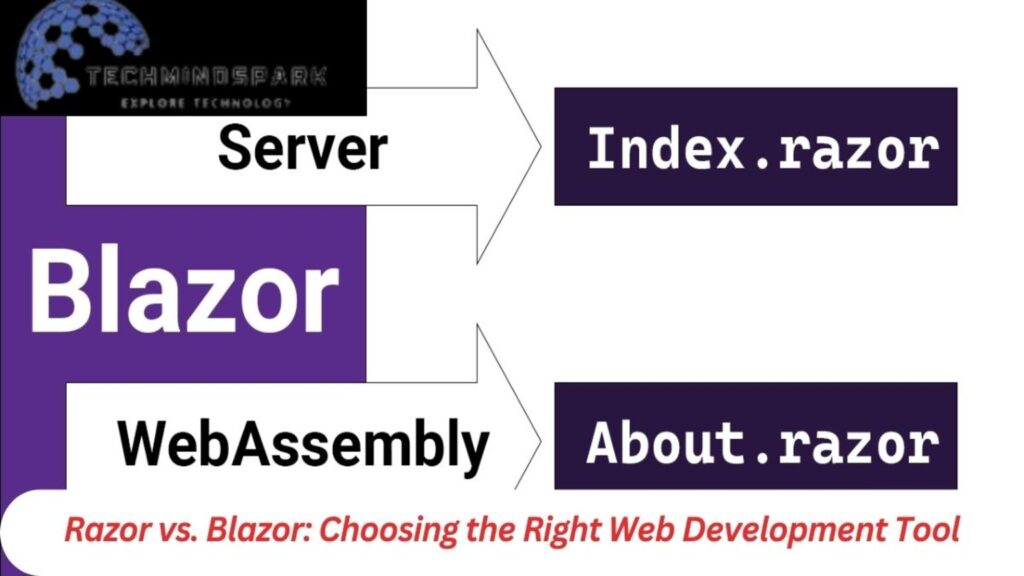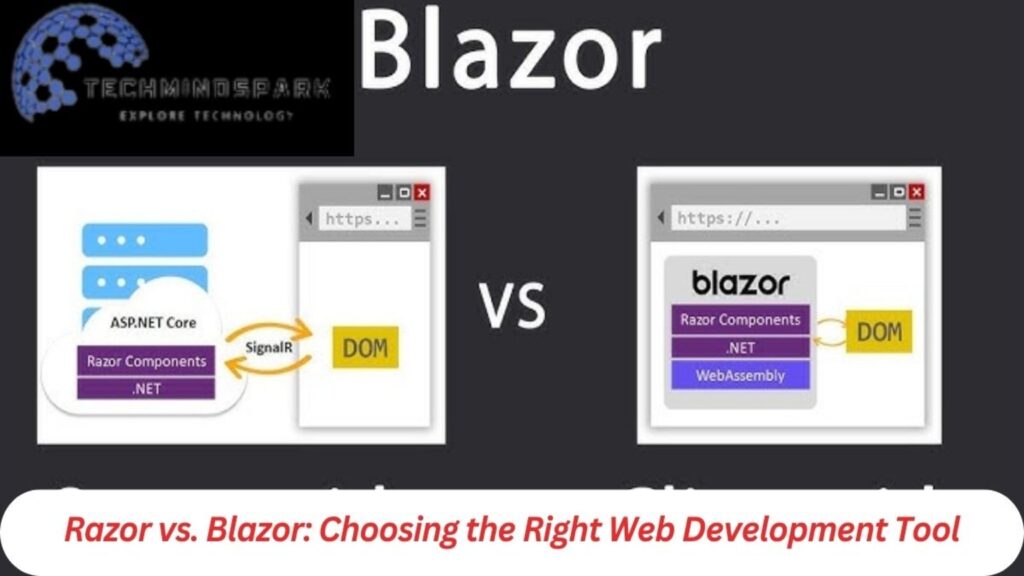Razor vs. Blazor: The appropriate technology is very useful and important for the success of business. Two prominent contenders in this realm are Razor and Blazor. Understanding their nuances and capabilities is crucial for making an informed decision.
Understanding Razor
Overview of Razor
Razor, syntax for embedding code into HTML markup, is a server-side technology developed by Microsoft. It provides a clean and concise way to blend server-side code seamlessly with HTML.
Use Cases and Applications
Razor finds its primary use in developing dynamic web pages with server-side logic. From simple websites to complex applications, Razor is versatile and efficient.
Advantages and Disadvantages
Advantages
Simplicity in syntax
Established and mature technology
Seamless integration with ASP.NET
Disadvantages
Limited support for client-side interactivity
Relies heavily on server resources
Exploring Blazor
Introduction to Blazor

Blazor is a modernized and also made by microsoft, but it operates on the client side using WebAssembly. And for the developers allows to write code in C# and run it directly in the browser.
Key Features and Components
Because to Blazor’s component-based architecture, reusable user interface elements can be created and dynamic, interactive web apps may be made without the need for JavaScript.
Pros and Cons
Pros
Single-page application capabilities
Rich set of components
Enhanced user interactivity
Cons
Learning curve for developers unfamiliar with Web Assembly
Limited ecosystem compared to more established technologies
Razor vs. Blazor: A Comparative Analysis
Performance
Razor vs. Blazor, being server-side, relies on server resources for processing. Blazor can outsource some work to the user’s browser thanks to its client-side capabilities, which in some cases may result in speedier performance.
Development Flexibility
Razor vs. Blazor excels in server-side logic, while Blazor shines in creating interactive and dynamic client-side applications. The choice depends on the project’s specific requirements and development goals.
Community Support

Razor vs. Blazor: Razor advantages from years of community contributions and is deeply included into the ASP.NET environment. Blazor, being distinctly more recent, is gaining traction, however its network guide is not as good sized as Razor’s.
Learning Curve
Razor’s syntax is easy for developers who are familiar with ASP.NET to understand. But switching to Blazor will be tough, specially for folks who aren’t familiar with Web Assembly.
Use Cases and Scenarios
When to Choose Razor
Razor is a solid choice for projects requiring server-side rendering and established ASP.NET integration. It’s suitable for scenarios where client-side interactivity is not a primary concern.
When to Choose Blazor
Blazor is ideal for projects demanding rich client-side interactivity and the ability to create single-page applications. It’s a suitable choice when leveraging Web Assembly’s capabilities is essential.
Hybrid Approaches
The benefits of client-side and server-side technologies may be balanced by combining aspects of Razor vs. Blazor to create a hybrid approach.
Case Studies

Real-world Examples of Razor Implementation
Case Study 1: E-commerce Platform
A leading e-commerce platform utilizes Razor for its server-side rendering, ensuring efficient content delivery to users.
Case Study 2: Interactive Dashboard
A dynamic dashboard application leverages Blazor’s components to deliver a seamless and interactive user experience.
SEO Considerations
Impact on Search Engine Rankings
Both Razor vs. Blazor can be optimized for search engines, but proper SEO practices may vary. It’s crucial to implement SEO-friendly techniques in the chosen technology.
Best Practices for SEO in Razor
Razor benefits from established SEO practices, ensuring proper indexing and visibility. Content delivery optimization and server-side rendering contribute to SEO success.
SEO Optimizations in Blazor
Blazor requires additional considerations for SEO, given its client-side nature. Proper handling of metadata, server-side prerendering, and utilizing JavaScript frameworks for SEO optimization are essential.
Future Trends
Razor’s Evolution
Razor continues to evolve, integrating new features and optimizations to stay relevant in the rapidly changing web development landscape.
Blazor’s Growing Popularity
Blazor’s popularity is increasing due to its continuous updates and community contributions, attracting more developers to adopt this modern framework.
Industry Predictions
Industry experts predict a coexistence of Razor and Blazor, with each technology catering to specific project requirements. The choice may depend on factors such as performance, development goals, and community support.
Conclusion
In the Razor vs. Blazor dilemma, the key lies in understanding project requirements. Blazor excels at typical server-side rendering, whereas Razor allows developers to create highly dynamic client-side applications. And also makes judgments along with knowledge based knowledge based on the specific needs of your project.
FAQs
Is Blazor suitable for all types of web development projects?
Blazor is ideal for applications requiring extensive client-side interaction, but its suitability depends on the project’s specific objectives and specifications.
Can I use Razor and Blazor together in the same project?
A hybrid combination of Razor vs. Blazor components can provide a comprehensive solution by combining the best features of both technologies.
How does Razor handle server-side rendering?
Razor excels in server-side rendering by embedding server-side code seamlessly into HTML markup, ensuring efficient content delivery.
What is the mastering curve for transitioning from Razor to Blazor?
Although ASP.NET developers may find Razor’s syntax clean, switching to Blazor might be difficult, specifically for folks that are not acquainted with Web Assembly.
Are there SEO considerations when using Blazor?
Yes, Blazor requires specific SEO considerations due to its client-side nature. Proper handling of metadata, server-side prerendering, and utilizing JavaScript frameworks are essential.
Visit: tech mind spark



